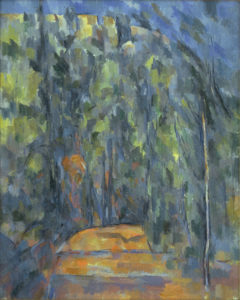R889 – La Route tournante en sous-bois, 1902-1906 (FWN340)
Pavel Machotka
(Cliquer sur les images pour les agrandir)
In the perfectly finished La Route tournante en sous-bois – that is, begun to all evidence with detached patches and woven together into a tight fabric without the slightest difficulty – color attains a greater importance than the forms; or better put, its forms are created by patches of color which remain distinct and call attention to their integration. The cobalts of the sky, for example, reach down into the yellow-greens of the leaves, setting up an incandescent tension between the warm and cool hues. The turn in the road is outlined clearly, as is the curve in the cliff above (with a few branches sketched in to prolong the cliff on the right), so that the two simple curves balance each other.
As abstract as the painting seems, it must not be taken to suggest a movement toward abstract painting as such; Cézanne’s means—the patches—are increasingly abstract, but his aim is always to give us a construction that parallels reality rather than substituting for it. The site (like that for Sous-bois provençal, R884-FWN339) simply had fewer irreducible elements in it, and the patches did more of the work of giving the painting form. (In one of his last landscapes, however, Le Jardin des Lauves, the patches do seem to be independent of the site; but the painting is in its early stages, and may represent only Cézanne’s starting point.)
Source: Machotka, Landscape into Art.


